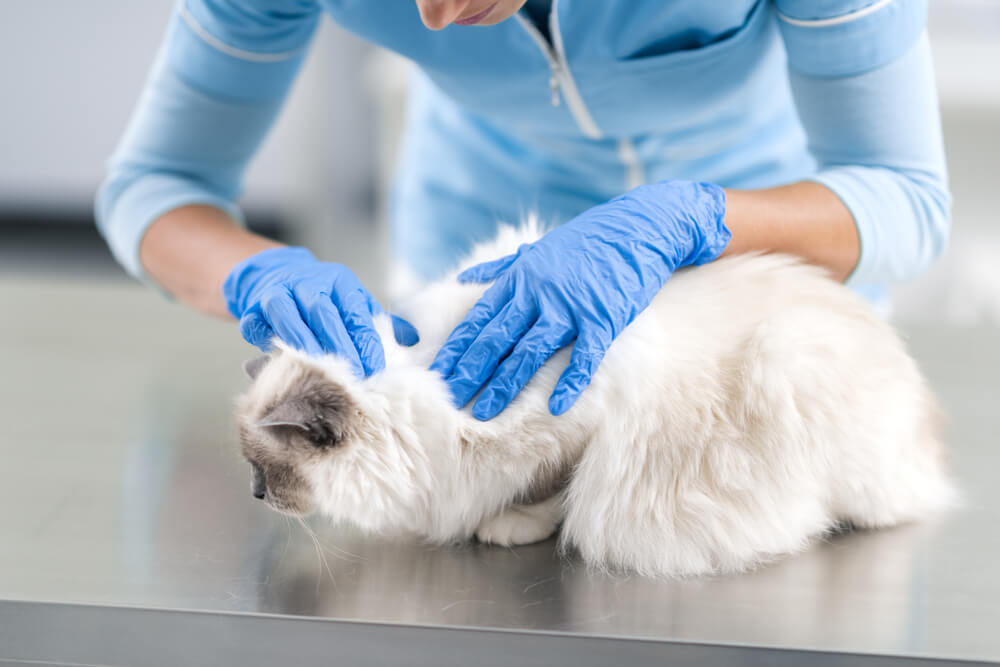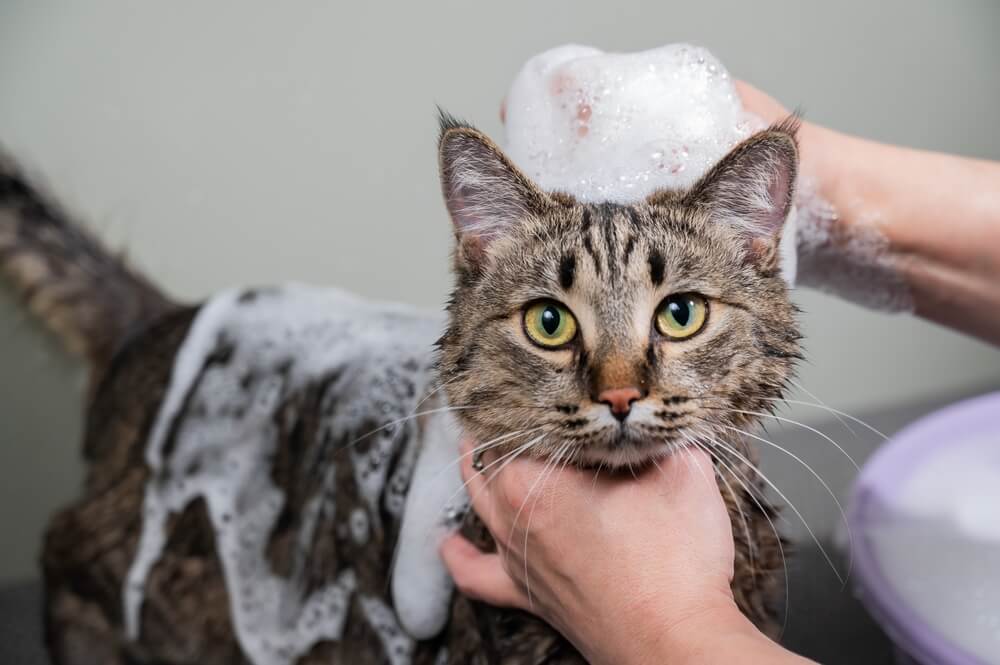
Excessive itching and scratching is often linked to inflammation of the skin. Sometimes this can start off as simple over-grooming, and then as the inflammation develops, the cat’s itchy skin can get worse. Inflammation is defined as redness, soreness (itchiness), heat, swelling, and loss of normal function: all of these features are seen in dermatitis.
The initial itchiness makes the cat want to scratch, lick and bite the affected areas, and then the more they itch themselves, the itchier it gets. This is a vicious circle. The cat scratching the itchy areas, along with excessive licking of themselves, makes the skin even more inflamed, and even more itchy.
Read on to learn facts about itchy skin in cats, and the reasons that cats feel itchy and begin to scratch themselves.
What Causes Itchy Skin in Cats?
Many different conditions can cause itchy skin in cats. The most common sequence of events begins with something initially irritating the skin (the so-called primary cause), which causes dermatitis (inflammation of the skin). Itchiness is also known as pruritus. Areas of inflammation are itchy, or pruritic.
Some of the most common reasons for itchy skin disease in cats include:
- Flea bites: flea infestations are the most common cause of itchy skin. Around 70% of itchy cats referred to skin specialists are completely cured simply by setting up a thorough flea control program, even when no fleas have been seen. This tells us that the absence of visible fleas is not enough to say that fleas are not causing the itchiness. A cat can have fleas on their body without being itchy, but cats start to itch when they have a flea allergy, which causes their immune system to overreact to flea saliva, causing intense itchiness.
- Food allergy, also known as cutaneous adverse food reaction (CAFR), caused between 12% to 21% of itchy skin in cats according to one study. Sometimes there might be other indications of different manifestations of food allergy, such as vomiting or regurgitating food (which is sometimes mistakenly blamed on hairballs).
- Atopy (environmental allergies), including house dust mite and pollen allergy, caused 12.5% of cases of itchy cats in one study
- Insect bites (such as harvest mites) occasionally cause itchiness, especially in the summer months.
- Ear mites and other mites. Skin parasites, especially ear mites, commonly cause itchy ears, and sometimes other parts of the body, particularly in kittens.
- Bacterial infections, including feline acne and abscesses, sometimes cause itchiness, as well as very obvious changes to the structure of the skin. Yeast infections are also sometimes seen.
- Fungal infections (ringworm). This is not usually an itchy condition, and is more likely to cause hair loss and bald areas of skin (also known as alopecia), but in severe cases, itchiness can be a feature.
How Is Itchy Skin Diagnosed In Cats?
A veterinarian will always ask cat owners about the full background to the itchiness. Are your pets indoor cats or do they go outside, too? When did the itchiness start? Was visible skin irritation present for long? Could your cat have been exposed to insect stings? Your vet will also ask you general questions about your pet’s health in case anything else is going on.
Any investigation of any problem in a cat starts with a careful, thorough physical exam of your pet. A cat with itchy skin might have other signs of illness, and it’s important to rule out other underlying diseases and to ensure that your cat’s health is generally good.
It’s also important to note the precise location of any itchy areas of skin, and to examine the precise type of changes in the skin and the fur, checking for scabs, dry skin, dandruff or greasiness.
Sometimes it’s possible to visually identify the cause of the skin problem (e.g. fleas or flea dirt, or harvest mites). Your veterinarian may use an otoscope to examine the inside of your cat’s ear canals to check for ear mites.
Specialized Testing

In some cases, your vet might recommend a skin scraping, biopsy, or other specialized tests.
Your veterinarian might use a Woods lamp (ultraviolet light) to check for the presence of fluorescence, which might indicate the presence of ringworm.
Your vet might also collect hair and take skin scrapings (using the edge of a scalpel blade) to be examined in the laboratory (either in-house, or sent to an external laboratory) to check for causes of the skin problem (e.g., certain parasites, ringworm, etc).
In some cases, your vet might recommend a skin biopsy. This involves surgically removing a small section of skin, usually under general anesthesia, to be sent to an external laboratory for detailed examination by a pathologist under the microscope.
Direct sampling of skin lesions in this way allows full scrutiny of the different structures of the skin, including hair follicles, any ulcers, granulomas, pimples, and other abnormalities. This can sometimes help to diagnose the specific underlying cause of the itchy skin.
Dietary Trial
The most effective diagnostic tool to test for food allergy is to put cat onto a dietary trial. For a trial period of six to eight weeks, the cat’s diet must include nothing but a diet that they have never had before.
A home-prepared diet is sometimes used, or you might prefer a prescription hypoallergenic cat food from your vet. You have to ensure that your cat eats nothing else for this period, which can be challenging if you have a multiple cat household, or if your neighbor sometimes feeds your cat.
If your cat stops itching when on the special diet, this strongly suggests that the cat must have been allergic to something that they were previously eating. The cat must then be kept on the special hypoallergenic diet for the long term, or different diets with restricted ingredients can be trialled, to try to fine tune which ingredient is causing the itchy skin.
Review of Environmental Allergies or Irritants
Your veterinarian might suggest reviewing your cat’s environment to identify any obvious environmental allergens or irritants that could be causing the itchy skin (such as household cleaners, sprays, or new carpets).
Atopy—an allergic reaction to dusts and pollens—is less well understood in cats compared to humans and dogs. It’s difficult to diagnose definitively. Cat don’t react as predictably to the type of skin or blood tests that are used in other species. Often, atopy is a diagnosis of exclusion: If every other cause is ruled out, and if it responds to anti-inflammatory medication, the itchy skin might be presumed to be atopy.
Trial Treatment

In some cases, trying certain medications can both diagnose the cause of the itchy and soothe your cat’s skin.
Even if a diagnosis has not been confirmed, veterinarians will sometimes give a trial treatment, and the response to this treatment can help to make a presumptive diagnosis. For example, if a cat develops itchy skin in the summer months, a veterinarian might suspect atopy (allergies to pollens) as the cause, and a trial treatment might be given (e.g., an injection of corticosteroids that lasts for three to four weeks).
If this is effective, this might be taken as strongly suggesting confirmation of this diagnosis, and future treatments can be arranged with this in mind if the cat starts to get itchy again. Any treatment can cause side effects, so this has to be borne in mind when trial treatments are suggested.
Referral to a Specialist
Your regular veterinarian might recommend referral to a veterinary dermatologist, who has a special interest in skin disease. This is generally recommended for exceptionally unusual cases of itchy skin.
Treatment Options for Itchy Skin in Cats
Treatment of cats with itchy skin depends on the cause of the problem. Some of the most common causes and treatments include the following:
- Fleas: The cat, any in-contact animals, and the cat’s environment must be treated for fleas and flea eggs.
- Food allergy or intolerance. The cat needs to be kept on a special diet which does not provoke an allergic reaction.
- Atopy (house dust mites and pollen allergies). Long term anti-inflammatory medication is often needed to deal with these cases of hypersensitivity to allergens (see below). This might need to be given just for a particular time of year (in seasonal cases involving pollen) or all year round (in cases where there is a continual presence of allergen, such as house dust mites).
- Insect bites (such as harvest mites). As well as preventing contact with the insects, anti-inflammatory medication is often needed.
- Ear mites and other mites. Treatment of the specific parasite; anti-inflammatory medication might need to be given until the itchiness has fully settled down.
- Bacterial skin infections (such as feline acne) might need courses of antibiotics as well as topical treatments.
- Fungal infections (ringworm). Topical (applied to the skin) and systemic (given orally) antifungal medication might be recommended.
Medication for Itchy Skin in Cats

Your veterinarian might prescribe baths with a special shampoo to help soothe your cat’s itchy skin.
As noted above, several different causes of itchy skin in cats (especially skin allergies) might require the use of medication. The most common treatments include:
- Anti-inflammatory medications. This might be given as tablets (e.g., prednisolone), oral liquids (e.g., cyclosporines), or depot injections (which last three to four weeks). These are prescription-only medications so they need to be used under the careful supervision of your veterinarian.
- Anti-fungal and/or antibacterial medications, given topically or orally.
- Antihistamines might sometimes be suggested but they are not very effective.
- Shampoos might be recommended as topical treatments for a number of different skin diseases.
- Dietary supplements such as omega-3 and -6 essential fatty acids are often recommended to generally improve the health of the skin and to improve the skin barrier.
Itchy skin is common in cats, but it can be tricky to diagnose and manage. It’s important to work with your veterinarian to identify the cause of the itchiness so that the best treatment can be given.
Also Read: Urticaria in Cats: Causes, Symptoms, and Treatment
-
Olivry T., Mueller R. S. (2017). "Critically appraised topic on adverse food reactions of companion animals (9): time to flare of cutaneous signs after a dietary challenge in dogs and cats with food allergies." BMC Vet Res, 13(1), 51.
-
Ravens, Philippa A., Xu, Bei J., Vogelnest, Linda J. (2014). "Feline atopic dermatitis: a retrospective study of 45 cases (2001-2012)." Vet Dermatology, 25(2):95-102, e27-8.







